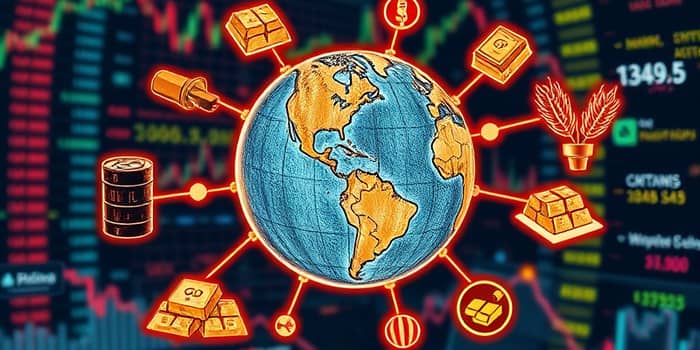The commodities market lies at the heart of global trade, providing the raw materials that fuel industries and sustain daily life. From the energy powering our homes to the grains that fill our tables, commodities are the unsung heroes of economic growth. Understanding this market equips investors, producers, and consumers with the tools to navigate price swings, seize opportunities, and manage risk.
In this comprehensive guide, we’ll explore the fundamentals of the commodities market, examine its key drivers, and provide actionable tips for anyone keen to engage with this dynamic ecosystem.
Understanding the Commodities Market
At its core, the commodities market is a platform—physical or virtual—where participants buy, sell, and trade raw or primary products. Commodities are typically standardized: one unit of a given grade is interchangeable with another, ensuring standardized and interchangeable commodity units that simplify global commerce.
These markets are divided into two broad categories:
- Hard Commodities: Extracted or mined resources, such as oil, natural gas, coal, metals like gold, silver, copper, and aluminum.
- Soft Commodities: Agricultural and livestock products, including wheat, coffee, sugar, corn, cattle, and poultry.
How Trading Works
Commodity trading occurs primarily through futures contracts: legally binding agreements to buy or sell a specific quantity of a commodity at a predetermined price and date. These contracts facilitate price discovery and risk transfer between producers, consumers, and speculators.
Key venues include major exchanges such as the Chicago Mercantile Exchange (CME), London Metal Exchange (LME), and Intercontinental Exchange (ICE). Traders submit bids and offers electronically or on the trading floor, creating a transparent market where price fluctuations reflect real-time supply and demand forces.
Key Drivers and Influencers
Commodity prices are shaped by a complex web of factors. Understanding these influences is essential to anticipate market movements and develop robust strategies. Major drivers include:
- Supply and Demand Fundamentals: Crop yields, mining output, and consumer consumption levels.
- Geopolitical Events: Conflicts, trade disputes, and sanctions that disrupt production or shipping lanes.
- Weather and Environmental Factors: Droughts, floods, and climate trends affecting agricultural yields or extraction processes.
- Currency Fluctuations: The strength of the U.S. dollar often inversely correlates with commodity prices.
- Interest Rates and Inflation: Cost of carry and holding inventory influence futures prices.
Monitoring these elements provides insights to navigate complex market dynamics, whether you’re hedging exposure or seeking speculative gains.
Market Participants
The commodities market hosts a diverse cast of characters, each with distinct objectives. Major participants include:
- Producers: Farmers, miners, and oil companies locking in prices to secure revenue streams.
- Consumers: Manufacturers, food processors, and airlines seeking predictable input costs.
- Speculators: Hedge funds and individual traders aiming to profit from price volatility.
- Investors: Pension funds and asset managers diversifying portfolios with commodity exposure.
By balancing these interests, the market achieves transparent price discovery and risk management for all participants.
Managing Risk with Derivatives
Derivatives are indispensable tools for hedging against unfavorable price moves. Futures and options contracts enable market participants to limit downside risk or leverage positions for higher returns. Below is an example of standard contract specifications on major exchanges:
These standardized contracts offer a framework to diversify exposure and safeguard investments, whether you’re a grain miller or an energy producer.
Technological Trends and Future Outlook
Innovation is reshaping commodities, making markets more efficient and accessible. Key trends include:
- Blockchain and Smart Contracts: Increasing transparency in supply chains and settling trades instantly.
- Environmental, Social, and Governance (ESG) Criteria: Growing demand for responsibly sourced and low-carbon commodities.
- Data Analytics and AI: Advanced forecasting models improving demand predictions and risk assessments.
These developments promise a market that is fairer, greener, and more resilient, opening doors for new participants and investment strategies.
Practical Tips for Beginners
Diving into the commodities market can be daunting, but a structured approach makes the process manageable:
- Educate Yourself: Read exchange publications, follow market news, and study historical price patterns.
- Choose a Trusted Broker: Ensure they offer the right tools, competitive fees, and solid customer support.
- Start Small: Use simulated trading platforms or small position sizes to build confidence.
- Implement Risk Controls: Set stop-loss orders and limit your total exposure to avoid large losses.
By taking these steps, you’ll develop the confidence to make informed decisions and steadily build your expertise.
Conclusion
The commodities market is a vibrant arena where physical goods and financial instruments intersect. Whether you’re hedging against price swings, diversifying an investment portfolio, or simply curious about the forces that shape global supply chains, mastering these basics will serve you well.
Remember, successful engagement in this market requires continuous learning, disciplined risk management, and an eye on both macroeconomic trends and granular supply data. Armed with this knowledge, you can navigate volatility, seize opportunities, and contribute to the efficient flow of goods that sustain economies and enrich lives around the world.
References
- https://www.investopedia.com/terms/c/commodity-market.asp
- https://www.pimco.com/us/en/resources/education/understanding-commodities
- https://www.investor.gov/introduction-investing/investing-basics/investment-products/commodities
- https://www.cfainstitute.org/insights/professional-learning/refresher-readings/2025/introduction-commodities-commodity-derivatives
- https://www.strike.money/stock-market/commodity-market
- https://www.investopedia.com/terms/c/commodity.asp
- https://groww.in/p/commodity-market










